Jewels of Northern India Tour
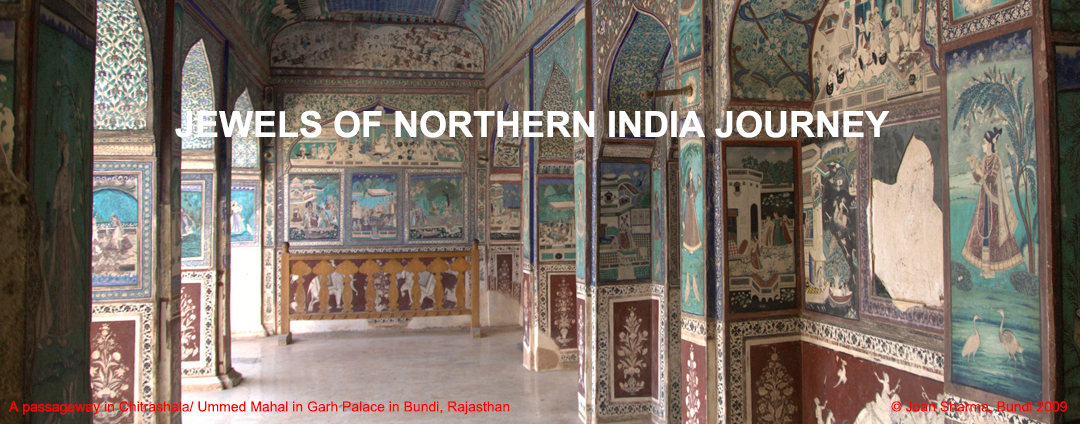
15 Hotel overnights / 16-day Journey – 15 hotel overnights, all inclusive (except alcoholic & non-alcoholic drinks and personal expenses) USD 4969 including roundtrip international flights.
ITINERARY :
1: Wednesday, October 22, 2025, SFO – DELHI :
Board the flight to New Delhi.
2: Thursday, October 23, 2025, DELHI :
Traditional Indian Welcome with Marigold Garlands on arrival in Delhi transfer to Best Western Maharani Bagh Hotel located in a posh residential south Delhi area and close to historical attractions like Humayun’s Tomb, India Gate etc.
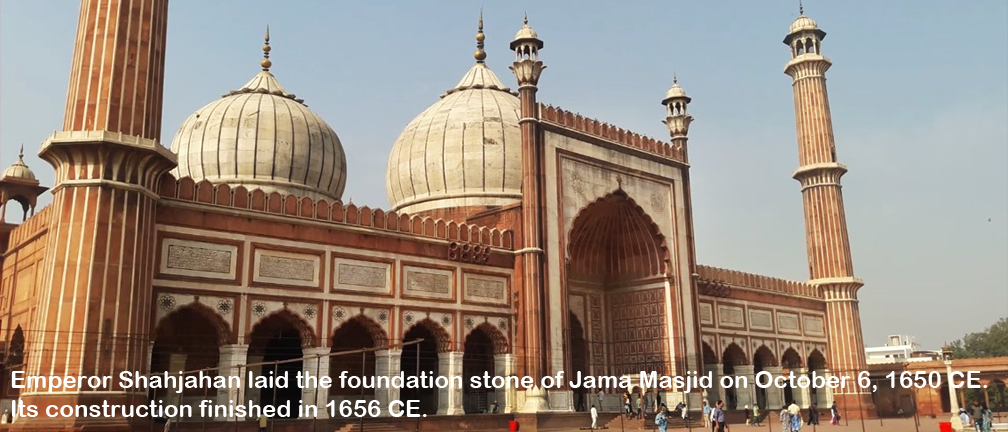
3: Friday, October 24, 2025, DELHI :
After breakfast sightseeing of Qutub Minar: its construction was initiated by Qutubudin-Aibak in 1198 CE upon becoming the first Sultan of Delhi. Qutubudin-Aibak was born in Turkestan of ethnic Mamluk descent. This was a region where youth went out to neighboring countries and joined their armies as mercenaries. They were enslaved when the army they were fighting with lost. Qutbuddin was sold to the Qazi (Islamic judge) of Nishapur in Persia. There he became favorite of his master because of his skills of horse-riding and archery among other warrior abilities. Qazi’s sons were jealous and they sold him after the Qazi’s death. He ended up as slave of Sultan Muhammad of Ghur province of Afghanistan. He led Sultan of Ghur’s army in the 1st and 2nd battle of Tarain and was appointed Governor of Lalkot, the capital of the last Hindu Chauhan dynasty kingdom. When Muhammad of Ghur was assassinated, Qutubudin-Aibak declared himself sovereign monarch and started the construction of Qutub Jami Mosque (a.k.a. Quwwat ul Islam Mosque) and Qutub Minar. The construction of minaret did not complete in his lifetime and many later Islamic rulers of various successive dynasties left their mark on this monument, which is now 5 stories high and 73 meters or 240 feet tall. The mosque was constructed using architectural elements of 27 Hindu and Jain temples that were demolished to build it. Much of the decorative pillars and facades of walls in the mosque were used without alteration in the new mosque, only the Arabic verses from the Quran were added new, sculpted by Hindu artisans who did not know the Arabic language and curved the endings of letters as they did with Sanskrit language carvings. Qutub Minar is a UNESCO World Heritage Site.

Later sightseeing of the Second Mughal Emperor Humayun's Tomb - its architecture may have influenced the construction of the Taj Mahal in Agra. Emperor Humayun died just six months after winning the throne of Delhi in 1556 CE. His widow, Hamida Bano Begum (a.k.a. Haji Begum) supervised its construction under Mughal Emperor Akbar’s rule. Having recently returned from Persia and its architect, Mirak Mirza Ghiyath, being a Persian, the monument has elements of Persian and Hindu architecture blended in it. Many later Mughal rulers are also buried in this mausoleum. Humayun’s Tomb is a UNESCO World Heritage Site.

Proceed further for sightseeing of India Gate (the war memorial), Parliament House and Presidents House (from outside) and for
lunch at Gulati’s Restaurant in Khan Market nearby. The British decided in 1911 to move their capital from Calcutta (now Kolkata)
to Delhi. Edwin Landseer Lutyens and his friend Herbert Baker were chosen for designing various buildings in the new capital. In
1914 the First World War started and continued until 1918. During this period the new capital’s construction was halted. After its
construction completed, the British capital was moved to New Delhi in 1931. India Gate was originally a monument to honor the
fallen Indian soldiers in World War I, but now honors Indian soldiers all subsequent wars.
In the afternoon stop by the Red Fort for photography from outside - the massive sandstone fort built by Shah Jahan on the banks
of river Yamuna. The fifth Mughal Emperor Shahjahan moved his capital from Agra to Delhi in 1636 and started the construction of
the walled “Shahjahanabad” city with 14 gates. The most important gates, Mori, Lahori, Ajmeri, Turkman, Kashmiri and Delhi Gates
still exist along with remnants of the wall. Within the city there were many monuments constructed but the most ambitious project
was the Red Fort – according to a horoscope done to determine the auspicious time for starting its construction, the work on
building the Red Fort started on May 12, 1639. In the Emperor’s Balcony in Diwan-i-Am or the Hall of Public Audience, there are a
set of marble panels that were made in Pietra Dure art by the Florentine jeweler, Austin de Bordeaux. The most famous of these is
the one depicting Orpheus playing the flute. There are many other palaces in the fort that were decorated with inlay of semi-
precious stones in marble. Red Fort is a UNESCO World Heritage Site.

Jama Masjid - is the largest mosque in India and stands across the road from the Red Fort, built by Mughal Emperor Shahjahan 1650-56 CE. It was originally called "Masjid-i-Jahannuma" or world reflecting mosque. Its construction was supervised by Vazir Saadula Khan and its chief architect was Ustad Khalil. About 25,000 people can pray here at a time. Overnight in Best Western Maharani Bagh Hotel in south Delhi.
4: Saturday, October 25, 2025, NEW DELHI – VARANASI :
Early morning at 5.30 am transfer to airport to board indigo flight departing at 8 am and arrive in Varanasi at 10 am. Drive about 26 kilometers in 35 minutes to Sarnath Buddhist archaeological site. one of India’s most important archaeological and religious pilgrimage sites. Buddha preached his first sermon to his initial five disciples at Sarnath.
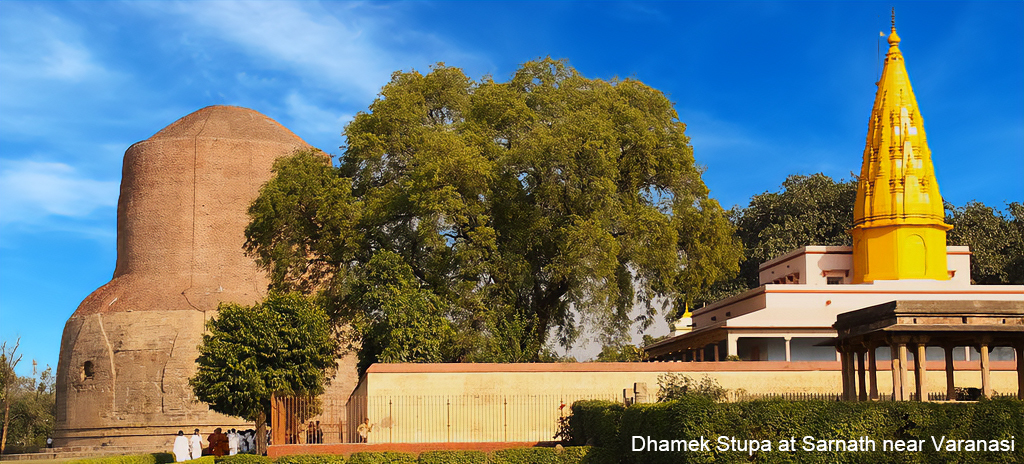
After leaving worldly and princely life behind, the youth, Siddharth Gautam Shakya had traveled to Varanasi for learning Sanskrit and ancient scriptures. He had undergone extreme penances at Sarnath, before moving to what is today known as Bodhgaya. It was here he found the path of moderation and enlightening. He returned to Sarnath to preach his first sermon to his initial five disciples.
It is accepted in all chronologies that Lord Buddha lived for 80 years and he passed away (Mahaparinirwana) at Kushalnagara (present day border of Bihar and Uttar Pradesh) in the Malla Republic. The dates of the Buddha have been derived from various chronologies which all recognize that Siddhartha Gautama lived for 80 years but disagree on the dates those 80 years encompass. The chronologies are: (1) Sri Lankan Long Chronology: birth circa 624 and death circa 544 BCE; (2) Corrected Long Chronology: birth circa 567 and death 487 BCE; Indian Short Chronology: circa 448 and death 368 BCE; Modern Chronology birth circa 563 and death circa 483 BCE.
The larger Dhamek Stupa at Sarnath was originally built by Mauryan Emperor Ashoka in 249 BCE but the present structure was renovated in circa 500 CE during the Gupta Period. The Mulgandhi Kuti Vihar (Sri Lankan Buddhist Temple) was built at the site where Buddha preached his first sermon. The archaeological museum in Sarnath has some of the most precious and well- preserved sculptures from this area. India’s national emblem was derived the 4-headed Lion capital, this original sculpture is on permanent exhibition in this museum. After sightseeing of Sarnath drive to the hotel for check-in. In the afternoon visit Varanasi’s most famous Durga and Sankat Mochan Hanuman Temple. Later visit the Man Mandir Palace of Maharaja Man Singh of Amber. His descendent, Sawai Jai Singh, the builder of Jaipur city, constructed one of his five astronomical observatories on the roof of this palace.

After sightseeing of the palace enjoy the Ganga Aartee at Dasaswamedha Ghat at Ganga River shore. Overnight in Ganges Grand Hotel in Varanasi.
5: Sunday, October 26, 2025, VARANASI – AGRA :
Early morning boat ride on the Ganga River to witness the morning religious rituals being performed by Hindu pilgrims on the Ghats (stone steps on river bank) and in the river itself. After breakfast visit Durga, Sankat Mochan Hanuman Temple and new Vishwanath Temple in Banaras Hindu University campus. Later wonder at one of India’s largest collections of Hindu, Jain, Buddhist, Rajput, Pahari and Mughal miniature paintings in the Bharat Kala Bhawan Art Gallery in the university. A Swiss scholar and artist, Alice Boner, had lived in Varanasi for many years in pre-independence India. Some of the art work is displayed in a special section in the art gallery. Around 2.45 pm depart from hotel to Varanasi Train Station to board the AC Chair-Car or Executive Class compartment of 20175 Vande Bharat train departing at 3.20 pm and arrive in Agra Cantt. Train station at 10.20 pm. Transfer to Grand Imperial Hotel for overnight.
The Grand Imperial is the only genuine 150 years old heritage hotel operating in Agra. The Grand Imperial was built in the early 1900 s as a Colonial Hotel for the British when the British Empire was at its peak. The hotel has history of hosting several leading celebrity heads of states such as The Crown Prince of England, Lady Edwina Mountbatten, (wife of Viceroy of India), Shah of Iran, Prince Aga Khan, Dr. Rajendra Prasad, (President of India), Jawaharlal Nehru, (1st. Prime Minister of India), Jai Prakash Narayan, Mohammed Ali Jinnah, (founder and President of Pakistan etc.) and many famous Bollywood film stars such as Dilip Kumar, Madhubala, Vaijayanti Mala etc. From the roof top of the hotel, one can easily get a view of the Taj Mahal, the Red Fort, Jama Masjid and many monuments of Agra. The hotel has a unique Colonial Victorian architecture blended with Mughlai style.
6: Monday, October 27, 2025, AGRA :
Wonder at the world-famous Taj Mahal in the glow of morning sunlight. Ample time in the vast complex for photographing and viewing the intricate Pietra Dure (inlay of semi-precious stones in marble art work, used in the exterior and interior of the monument.
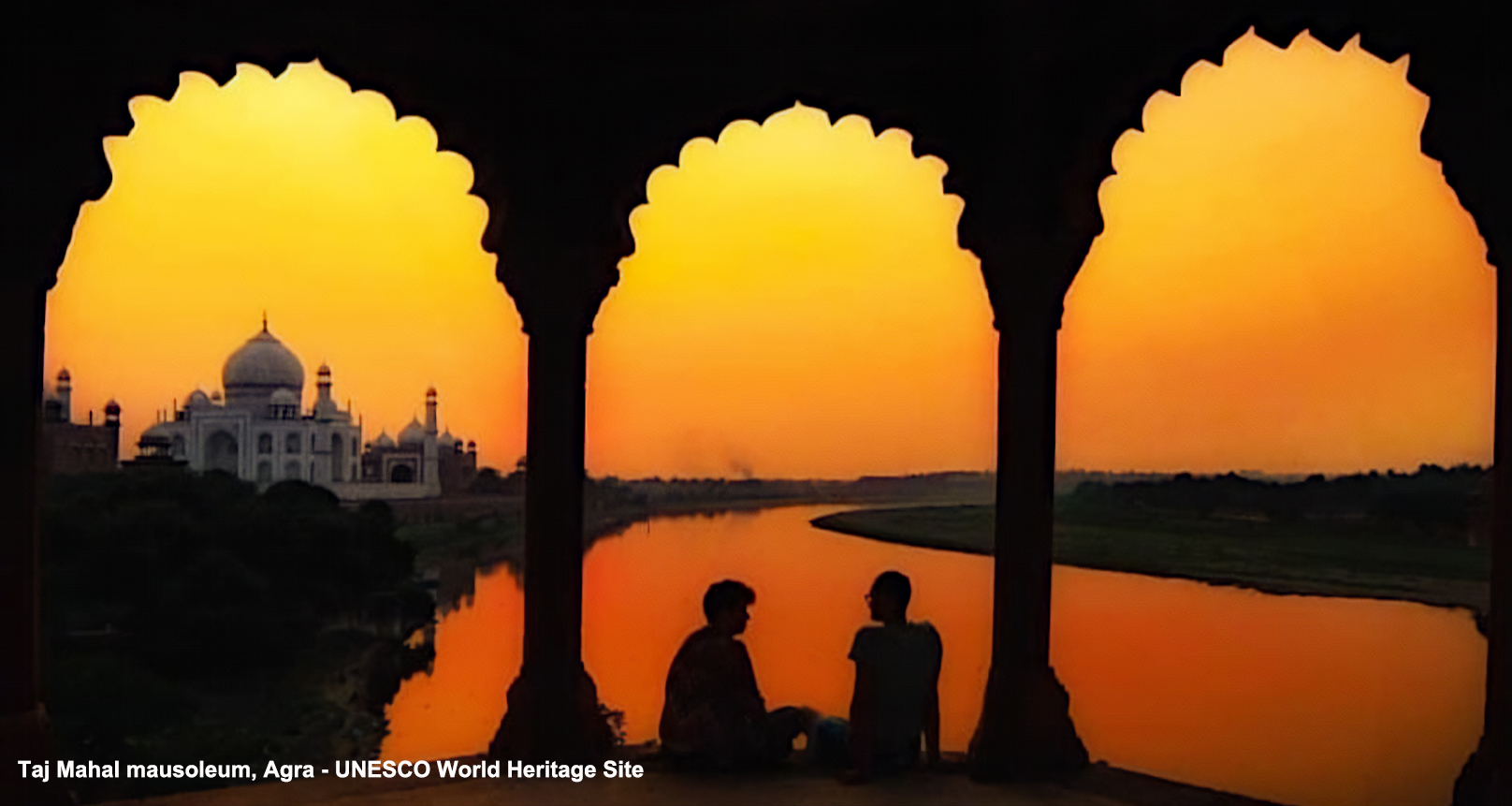
Prince Khurram (later Emperor Shahjahan) and his father Prince Salim met their favorite future queens in a mock market called Meena Bazaar to celebrate the Persian new year festival of Nowruz in Agra Fort. Prince Salim wanted to marry Mehr un Nissa Begum, the daughter of Mirza Ghiaz Beg but Emperor Akbar did not want Shi’a influence in the royal family so he asked Mirza Ghiaz Beg to marry his daughter to an Afghan commander and had him posted in Bihar. Prince Khurram was third eldest and not initially in direct line of succession. He was betrothed to Arjumand Bano Begum on April 5, 1607 but Prince Salim delayed his marriage. After death of Emperor Akbar, Prince Salim ascended the throne with the title of Emperor Jahangir and it was only in May 1610 that Mehr un Nissa, the widow of the Afghan commander finally agreed to marry him. He honored her with the title of Nur Jahan (light of the world) after his marriage. One year later on May 10, 1612, Prince Khurram was finally allowed to marry his beloved Arjumand Bano Begum, who was the niece of Mehr un Nissa (her brother’s daughter and granddaughter of Mirza Ghiaz Beg). She received the title of Begum Mumtaj Mahal after her marriage with the Mughal prince. Begum Mumtaj Mahal was 19 years when they married. She was his constant companion and most trusted advisor. During their 19 years of marriage, she gave birth to 14 children of which only 3 daughters and 4 sons survived. The youngest son, Aurangzeb fought a war of succession against his elder brothers. One after the other he won against all of them, had all the brothers killed and then put his father, Emperor Shahjahan, under arrest in his own palaces in Agra Fort. Queen Mumtaj Mahal died on June 17, 1631 while delivering her 14th child, a daughter, Gauhar Ara Begum, who survived and lived in Shahjahanabad to a ripe age of 75 years.
The site of the Taj Mahal mausoleum was a palace of the Maharaja of Amber, Mirza Raja Jai Singh. The emperor asked him to give the palace back to him and gave him other properties in lieu. The queen was temporarily buried in Burhanpur where she died in an army encampment. The body was transferred to Agra and again temporarily buried in the northwest section of the garden of Taj Mahal where a red sandstone enclosure still marks the site of her temporary burial. The Taj Mahal mausoleum was completed in 1648 according to an inscription on its main gate. The tomb was built exclusively for Queen Mumtaj Mahal, so her grave stone is in the center of the grave chamber. Emperor Shahjahan died on January 16, 1666 in Mussamam Burj Palace in Agra Fort. He was buried by the queen’s side and his grave stone is the only architectural feature in this mausoleum that is not symmetrical. Taj Mahal, is a UNESCO World Heritage Site.
After breakfast enjoy a demonstration of the art of Pietra Dure (inlay of semi-precious stones on marble surface) at Agra's oldest emporium where the not for sale section has some artifacts with inlay work much finer than the most intricate art work in the Taj Mahal itself and perhaps the world's best.
In the afternoon sightseeing of Agra Fort. Emperor Akbar moved his capital to Agra from Delhi in 1558 but the construction of the Agra Fort started in 1565. It was built on the ruins of an earlier fort named Badalgarh. The first Mughal Emperor Babur had occupied this fort after his victory in the battle of Panipat in 1526 CE. His son, second Mughal Emperor Humayun was crowned in the old fort of Badalgarh in 1530. With about 4000 laborers and craftsmen toiling for 8 years the fort's construction was completed in 1573. The entire fort was built with narrow flat brick masonry work and laminated with red sandstone from the stone quarry at Sikri village west of Agra. According the Emperor Akbar's official biography written by his trusted friend, Abul Fazl, there were about 5000 buildings in the fort. Some of these buildings were demolished to make way for white marble palaces of Emperor Shahjahan, facing the Yamuna River, on the eastern side of the fort. Most of the buildings in western side were converted in to soldier’s barracks by the British East India Company. The western part of the fort is still occupied by Indian military. Emperor Akbar's style was greatly influenced by the architecture of the states of Gujarat and Bengal. It is also very unique because it reflects Emperor Akbar's tolerant religious philosophy. The best of example of his architecture is visible in the palace popularly called Jahangiri Mahal. In 1666 the great Maratha warrior, Shivaji met with Emperor Aurangzeb but the Mughal Emperor broke his promise and arrested him. He managed to escape in a spectacular manner by hiding in fruit baskets for distribution to poor. The Jat and Maratha rulers occupied Agra Fort in later years. Finally in 1803 the British East India Company captured it and demolished most of its monuments, only about 30 monuments have survived in the south-eastern side of the fort. In 1983 the Agra Fort was declared a UNESCO World Heritage Monument.
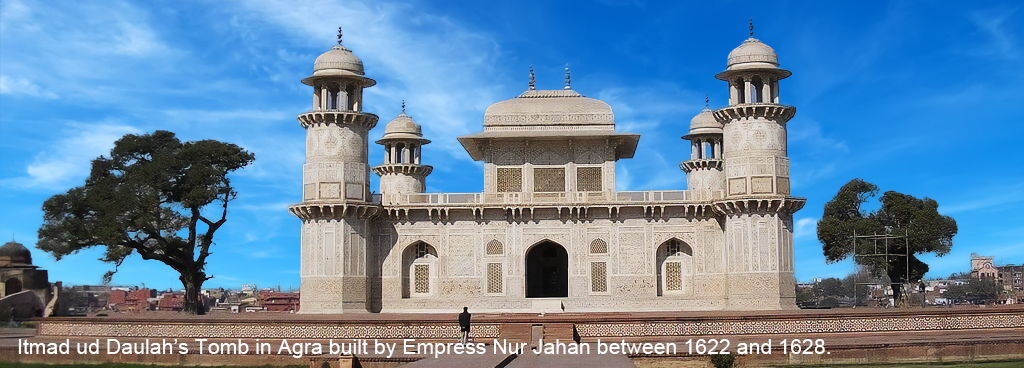
Later sightseeing of the Tomb of Itmad-ud-Daulah. This is the mausoleum built under supervision of Empress Nur Jahan for her parents, Mirza Ghiaz Beg and Begum Asmat in 1628 CE almost 7 years after her father's death. Mirza Ghiaz Beg received the title of Itmad-ud-Daulah or ‘Lord of Treasure of the Empire’ from Emperor Jahangir. Upon arrival check in to the hotel. On the way to hotel wonder at the largest collection of Zerdozi Embroidery Art in India. This embossed embroidery art is attributed to the Mughal Empress Nurjahan. It uses silver, gold and colored silk thread embroidery on silk and velvet background and is one of the unique arts originating in Mughal period. Overnight in Grand Imperial Hotel in Agra.
7: Tuesday, October 28, 2025, AGRA – FATEHPUR SIKRI – JAIPUR (206 kilometers, 3.5 hour’s drive) :
After breakfast drive one hour to Fatehpur Sikri for sightseeing of Mughal Emperor Akbar’s deserted capital and the tomb of Sufi saint Sheikh Salim Chishti in the courtyard of the grand mosque. Emperor Akbar did not have a male heir to his throne for a long time. He came to the Sikri village to seek the blessings of the Sufi saint, Sheikh Salim Chishti, who correctly prophesied that Emperor Akbar would have three sons. The emperor moved with his Hindu queen, Jodha Bai, to Sikri village to live with the saint and started building an alternative capital at the site which was earlier a query for red sandstone. The entire capital was built with red sandstone from the ridge on which it is located. The first-born son was named Salim after the Sufi saint. The second was named Murad or the longed one. The third son was named Daniel, probably influenced by the Jesuit priests from Goa who were invited by the emperor to teach him about Christianity. Emperor Akbar developed the philosophy of “Sulah Qul” – living in harmony with all religions. Later he developed his own religion, Din-i-Ilahi or faith of God. His dear friend and official biographer, Abul Fazl, was among the first to convert to the new religion which he described in “Akbar Nama”.
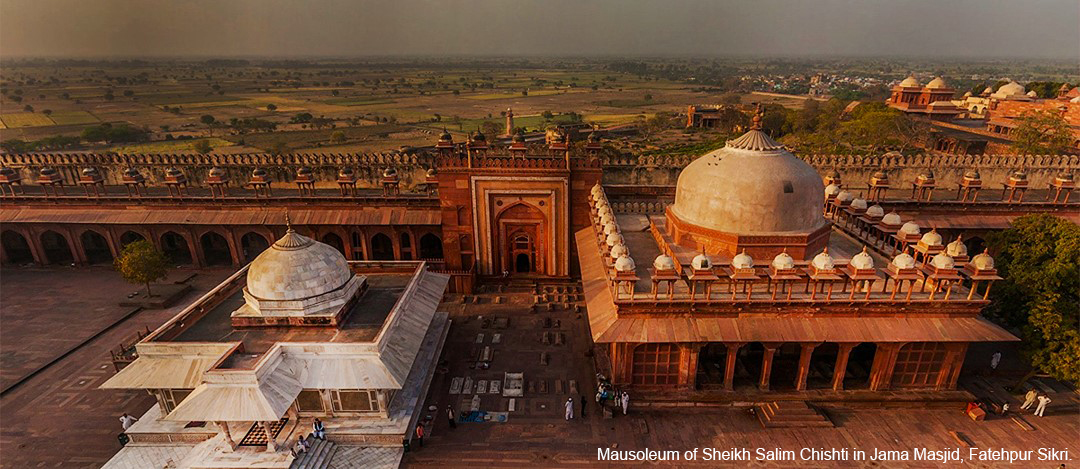
Visit the grand Friday “Jama Masjid” and the mausoleum of Sheikh Salim Chishti, which was renovated using the white marble by later Mughal Emperors. After Emperor Akbar moved away from this capital, living there only 14 years, the capital was deserted for more than 400 years until Lord Curzon, British Viceroy of India ordered the Archaeological Survey of India to restore this fascinating capital and this renovation work is still going on. The palaces were all covered with wild forest and wild animals lived in the palaces. The “Dargah” or mausoleum of the saint was never deserted and people from Agra and nearby villages have been coming there to seek the saint’s blessings for centuries.
Drive further to Jaipur. On arrival in Jaipur check in to the hotel. In the late afternoon demonstrations of wooden block printing on cotton textiles, woolen carpet weaving as well as cutting & polishing of precious & semi-precious stones.
An early 19th Century Palace of Shahpura royal family, Shahpura House in Jaipur encapsulates the essence of Rajasthan's aristocratic past. Shahpura, being the head seat of the Shekhawat clan, the House is also the residence of Shahpura royal family. It was the vision and passion of Maharaj Surendra Singh Shahpura which has made this house into an awarded luxury heritage hotel and still remains under the ownership of his esteemed descendants. A testament to the architectural brilliance of the Shekhawati region, it stands tall as a living witness to the opulent lifestyle of the bygone era. Its walls whisper stories of illustrious rulers and their majestic courts. Meticulously blending the allure of history with modern comforts, this heritage abode pays homage to its legacy while offering impeccable amenities. Step into a realm of regal enchantment with the grandeur of its halls, adorned with delicate frescoes, old wall paintings, marble floors and ornamental pillars. The Durbar Hall in the captivating premises, served as an exclusive venue for the king's Diwan-e-Khas, where the royal court convened alongside trusted advisors to discuss matters of great importance. Reserved for royal family functions, this hallowed hall welcomed only a select few into its embrace. Today, the Durbar Hall extends its splendor to in-house guests, granting them the privilege of capturing Instagram-worthy moments within its resplendent confines. Adorned with exquisite handcrafted Nakashi with goldwork embellishing the pillars, every detail showcases the extraordinary artistry that breathes life into the space. The ceilings bear the intricate tapestry of traditional Shekhawati inspired, breathtaking glasswork that enchants all who gaze upon it. The family portraits adorning the walls, offer a glimpse into the lives of the illustrious lineage that once graced these halls. The palpable sense of connection to the palace's regal past invokes a nostalgic longing for the opulent era of princely Rajasthan. The regal ambience and meticulously preserved architecture of the Shahpura House, create a captivating backdrop for exchanging vows, while sprawling gardens provide the perfect canvas for extravagant festivities. The palace stands proudly adorned with accolades that recognize its excellence with World Luxury Awards, 2018 and World Travel Awards, 2023. Overnight stay in Shahpur House Hotel in Jaipur.
8: Wednesday, October 29, 2025, JAIPUR :
After breakfast full day sightseeing of Amber and Jaipur starting with a drive through the walled pink city to Hawa Mahal, which is mere facade with about 3 feet deep balconies behind latticed screens where royal family women used to sit to watch the royal processions on the street.

Drive further north through pink city to Amber Fort to enjoy a majestic elephant ride to the hilltop palaces of Sawai Jai Singh, Mirza Raja Jai Singh and Maharaja Man Singh (one of nine jewels of Emperor Akbar’s cabinet of nobles). On the way back stop at the Jal Mahal Island Palace.
Jaipur City was designed by Maharaja Sawai Jai Singh and his principal architectural and city planning advisor, Vidhya Dhar Bhattacharya. On July 6, 2019 the entire walled and painted pink city has been declared a UNESCO WORLD HERITAGE SITE.
In the afternoon visit the City Palace including the Royal portraits gallery in the Diwan-i-Am (Hall of Public Audience), the Diwan-i- Khas (Hall of Private Audience), the Mor Chowk (peacock) courtyard of Chandra Mahal, the palace where the present head of the Jaipur royal still resides. When he is in the building the family’s royal flag flies on its roof.
Later wonder at the 16 working astronomical instruments of the Jantar Mantar observatory of Maharaja Sawai Jai Singh. The Brihat Samrat Yantra (large sundial) here has an accuracy of 2 seconds. This masonry astronomical observatory is the largest and best maintained of the five observatories constructed in Ujjain, Varanasi, New Delhi and Mathura. The observatory in Mathura was demolished in the colonial British East India Company period. Overnight stay in Shahpura House Hotel in Jaipur.
9: Thursday, October 30, 2025, JAIPUR – SAMODE PALACE – NAWALGARH (114 kilometers, 2 hour’s drive) :
After breakfast drive about 45 kilometers or 26 miles in 1 hour to Samode Palace for sightseeing and lunch.

Drive further to Nawalgarh for sightseeing of the Havelis (Anandilal Poddar, Bansidhar, Murarka and Chowkhani). Vivaana Museum Hotel is a true feast for the senses, it is a magnificent Heritage Museum Hotel and Restaurant. Vivaana Museum Hotel invites you to cherish the rich cultural heritage, traditions, and stunning architecture of Shekhawati. Known for their vibrant colors, intricate designs, and details, the paintings that adorn the walls of Vivaana Museum Hotel would be thoroughly enjoyed by fellow enthusiasts. These paintings were typically created using natural pigments and dyes. Many of them are inspired by Indian mythology and depict gods and goddesses, while others depict scenes from everyday life, such as farmers at work or women at a well. Overnight in Vivana Museum Hotel, Nawalgarh.

10: Friday, October 31, 2025, NAWALGARH – PUSHKAR (196 kilometers, 4 hour’s drive) :
After breakfast drive to Pushkar and check-in to Pushkar Bagh Resort Hotel. Sightseeing of Brahma Temple & temples on lake side. Pushkar is a popular pilgrimage center for Hindus living in nearby region. During October / November the Pushkar Camel Fair is organized in connection with celebration of Kartik Purnima – the full moon on 15th day of the Kartik month of Hindu calendar. Built with a blend of Rajput and Mughal styles, the Gulab Niwas Palace Hotel is walking distance from all attractions of Pushkar: 0.5 km from the 14th-century Brahma Temple, 0.7 km from Pushkar Lake and 2 km from Pushkar Terminus train station. The relaxed rooms feature Colonial-style furniture and private city-view balconies, as well as sitting areas, flat-screen TVs and Wi-Fi (fees). Room service is available. The hotel has an Indian restaurant called Arogo with a city-view which offers vegetarian Indian food in addition to a cafe called the Desert Rose Cafe which serves wood fire oven pizzas and fresh coffee and teas. After lunch sightseeing of the vast Pushkar Camel Fair grounds by Camel Carts. Later walk in the main street of Pushkar to Brahma Temple. Overnight in Gulab Niwas Palace, Pushkar.
11: Saturday, November 1, 2025, PUSHKAR – JODHPUR (232 kilometers or 144 miles, 4.5 hour’s drive) :
This morning after breakfast, depart for Jodhpur, known as the "Blue City" due to its blue-painted houses.
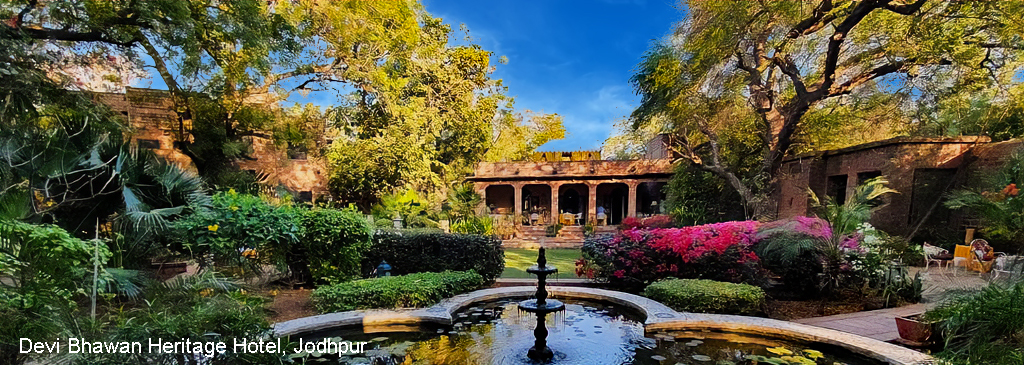
On arrival, check in at your hotel and enjoy some leisure time. Explore the city's vibrant markets and soak up the local culture at your own pace. Overnight in Ranbanka Palace Hotel, Jodhpur.
12: Sunday, November 2, 2025, JODHPUR :
Enliven the majesty and grandeur of Jodhpur, the erstwhile capital of Marwar kingdom. The Mehrengarh Fort, an amazingly constructed royal residence perched on the lone mountain surrounded by the desert plain. From top it surprises the visitor with panoramic views of the blue city below. The buildings inside the fort are intricately yet beautifully designed. The interiors of the palaces are covered with colorful paintings with lots of gold foil decorations. Each section is unique in its design. These palaces are so very different from the palaces in other former Rajput capitals.
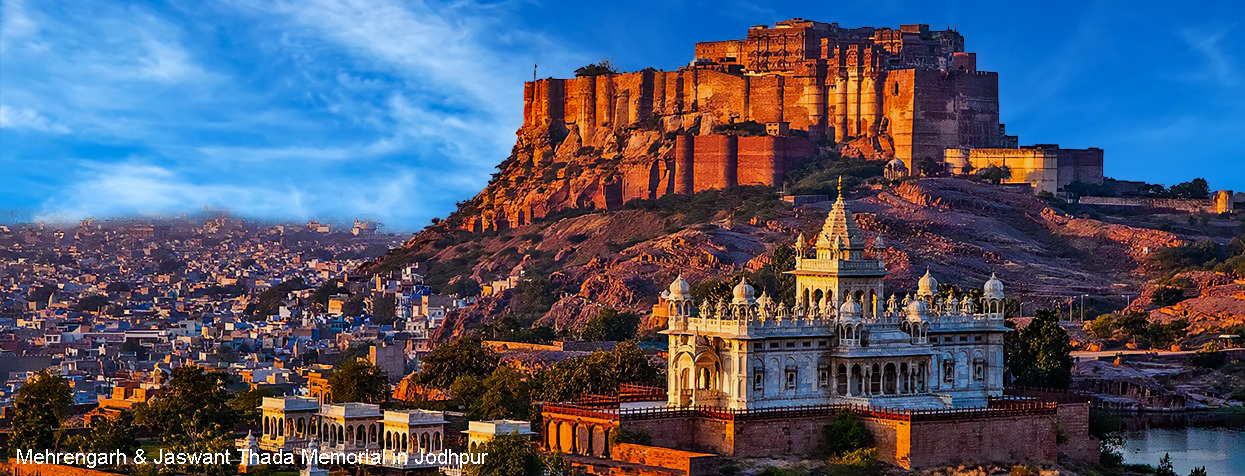
Half way up the mountain on which the fort is situated is a grand white marble memorial for the former Maharajas of Marwar. The Jaswant Thada Memorial was constructed by Maharaja Sardar Singh to commemorate and honor his father, Maharaja Jaswant Singh I in 1899. The building offers unique latticed screens The interior of the memorial is decorated with intricate carvings, latticed screens and colorful frescoes.
The center of the city is the grand Clock Tower with a bustling bazaar around it with vendors selling fragrant spices and perfumes to colorful cloth material merchants. The streets are full of all different modes of transport ranging from camels and horses to bicycles, pedal rickshaws, scooters, autorickshaws, cars, vans, and variety of mini- and large coaches. Cows are holy, they can block any passage or roads and every goes around them if they can!
The Marwar Maharajas had moved from the Mehrengarh Fort when they constructed the new Umaid Bhawan Palace in 1943. Maharaja Umaid Singh laid foundation stone of the 347-room palace in 1929. Henry Vaughan Lanchester, a contemporary of Sir Edwin Lutyens, the planner of British East India Company’s New Delhi, was selected as the architect. Lanchester designed the building blending western and Indian architectural features referred to Beaux Art or Indo Deco Style. One part of the palace is managed as luxury heritage hotel call Taj Umaid Bhawan Palace, in another part the present owners live while a third part has historical museum open to public. Overnight in Ranbanka Palace Hotel, Jodhpur.
13: Monday, November 3, 2025, JODHPUR – UDAIPUR (137 kilometers or 85 miles to Ranakpur, 2.5 hour’s drive/90 kilometers or 56 miles, 2 hour’s drive) :
After breakfast, check out from the hotel and embark on a scenic drive to Udaipur. Stop at Ranakpur to visit the awe-inspiring Chaumukha Mandir (Four-Faced Temple). This Jain temple is a masterpiece of architecture, with its 1444 intricately carved pillars and exquisite craftsmanship. After sightseeing of the Jain temple continue the drive further to Udaipur, often called the "City of Lakes." On arrival, check in at your hotel and enjoy the rest of the day at your leisure. Overnight in Casa Blanca Lake City Hotel, Udaipur.
14: Tuesday, November 4, 2025, UDAIPUR :
Today, after enjoying a delicious breakfast, explore the captivating city of Udaipur. Your first stop is the majestic Udaipur City Palace, situated above Lake Pichola. This magnificent palace, constructed entirely out of marble and granite, is a testament to luxury and grandeur. Inside, you'll be awestruck by the intricate inlays of colored glass, engravings, towers, and balconies. It's a truly unique experience that showcases the rich history of Rajasthan. Next, you'll visit the beautiful Jagdish Temple, a 16th-century temple dedicated to Lord Vishnu. This temple is the largest and most splendid in Udaipur, offering a glimpse into the city's religious heritage. As you drive past Fateh Sagar Lake, relish the Sahelion-ki-Bari, also known as the “Garden of the Maids-of-Honor”. This enchanting garden boasts delicately chiseled kiosks, fountains, and elephants in its four pools. It's the perfect place to soak in the serene beauty of Udaipur.
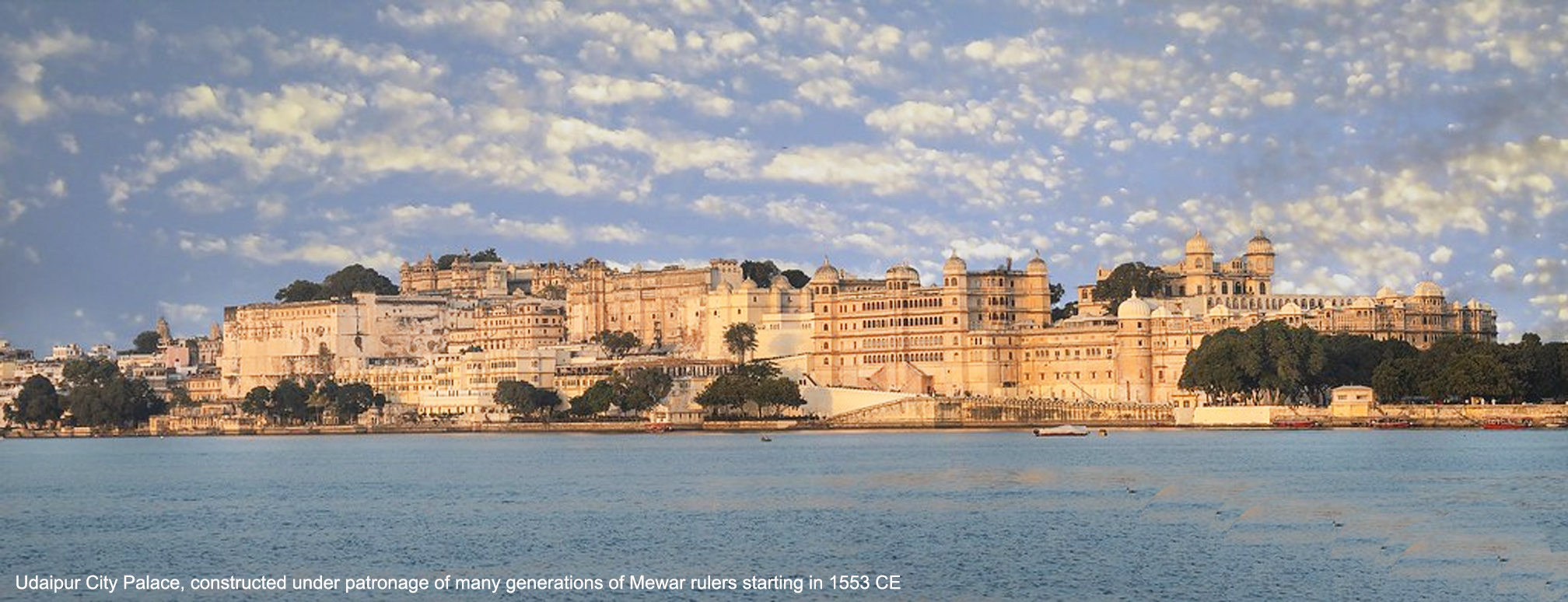
The boat ride on Lake Pichola offers a delightful experience of sailing past picturesque Ghats (steps leading down to the water) and palaces. As you cruise along the tranquil waters, you'll witness the majestic beauty of Udaipur's famous landmarks, such as the City Palace and Lake Palace, which appear to float on the lake's surface. One of the highlights of the boat ride is a stop at the island of Jag Mandir, a magnificent 17th-century water palace. This island palace provides a captivating glimpse into the royal heritage and architecture of Rajasthan. It's a serene and enchanting journey that allows you to immerse yourself in the splendor and history of Udaipur's lake city. Overnight in Casa Blanca Lake City Hotel, Udaipur.
15: Wednesday, November 5, 2025, UDAIPUR – CHITTORGARH - BUNDI (111 kilometers or 69 miles to Chittorgarh/ 155 kilometers or 96 miles) :
After breakfast at around 8.30 am drive about 2 hours to Chittorgarh for an in depth sightseeing of the massive fort’s historical part.

Drive another 1.5 hours to Bundi. Sightseeing in Bundi: Taragarh Fort; Garh Palace; Badal Mahal for paintings; Sukh Mahal on Jait Sagar Lake; Chowrasi Khambon ki Chattri; Bhoraji ka kund artificial reservoir; Nawal Sagar Lake; Phool Mahal & Phool Sagar Lake; Chattra Mahal in Fort; Hathi Pol and Shikhar Burj).
Like Jodhpur this much smaller town also has most houses painted in blue color.
Bundi's highlight is its fantastical palace, rising from the hillside with faded parchment cupolas and loggias. It's like stepping into a
magical world frozen in time. Upon arrival, you'll check into our hotel and later in the afternoon, embark on a delightful walking tour
of Bundi. You’ll visit one of the most beautiful step-wells in town and explore the vibrant and characteristic marketplaces. The walk
will culminate at the Garh Palace, also known as Bundi Palace, a partly decaying edifice that seems to grow out of the rock. Inside,
you'll be captivated by the fabulous turquoise-and-gold murals, the palace's chief treasure. Take your time to absorb the magical
atmosphere of this historical gem. The rest of the day is yours to relax and enjoy. Overnight in Bundi.
16: Thursday, November 6, 2025, BUNDI:
Full day to explore Bundi. Overnight in Bundi
17: Friday, November 7, 2025, BUNDI – SAWAI MADHOPUR – DELHI (350 kilometers/217 miles in about 4 hours 18 minutes) by train :
After breakfast transfer to Sawai Madhopur Train Station. Board the 1st class air-conditioned compartment in train 12953 August Kranti Tejas Rajdhani Express train departing at 5.35 pm and arrive in New Delhi railway station at 9.43 pm. Transfer to a hotel for freshening up and farewell dinner before transfer to Indira Gandhi International Airport for boarding the return flight.
18: Saturday, November 8, 2025, NEW DELHI - USA :
Later transfer to Indira Gandhi International Airport to board the return flight.
Please call for choosing hotels and any changes in the above-mentioned itinerary as well as the price.
Suggested Hotels :
| CITY | HOTEL | NO. OF NIGHTS |
|---|---|---|
| NEW DELHI | Best Western Maharani Bagh | 2 |
| VARANASI | Ganges Grand Hotel | 1 |
| AGRA | The Grand Imperial Hotel | 2 |
| JAIPUR | Shahpura House | 2 |
| NAWALGAHR | Roop Niwas Kothi | 1 |
| PUSHKAR | Gulab Niwas Palace | 1 |
| JODHPUR | Ranbanka Palace Hotel | 2 |
| UDAIPUR | Casa Blanca Lake City Hotel | 2 |
| BUNDI | Braj Bhushan Heritage Haveli | 2 |
| NEW DELHI |
Single Room Supplement: US$ 995.00
INCLUDED IN THE ABOVE PROPOSED ITINERARY :
- 15 overnights - accommodations in the mentioned or similar hotels inclusive of taxes on double or twin room occupancy basis.
- Daily buffet breakfast and dinner at your hotels. Lunches in city restaurants or as described in itinerary.
- Deluxe AC coach as per the program.
- Daily bottled water in car.
- English speaking local guides as per program.
- Assistance at each city by our company’s local representative.
- Rickshaw ride at Jama Mosque in Delhi.
- Elephant ride at Amber Fort in Jaipur.
- Boat ride in Pichola Lake with sightseeing of Jag Mandir Island Palace.
- First class AC train from Sawai Madhopur to Delhi.
- Farewell dinner in Delhi.
- All taxes, parking fees, interstate taxes, state taxes, driver’s allowance etc.
CASH & CREDIT CARDS :
Cash transactions can generally be made in either U.S. dollars or local currency. U.S. dollars should be recently issued bills in smaller denominations. The import and export of Indian Rupees is strictly prohibited unless you are a resident of India. So make certain to conduct any currency exchanges within India. Major credit cards are accepted on a limited basis, mainly in the larger shops, hotels and restaurants. Access to ATM machines is widespread in cities and towns but limited in rural areas.
NOT INCLUDED :
- US citizens require their passports to be valid for six months after return date from India i.e. July 14,2020. Visa for travel to India can be applied online at: https://indianvisaonline.gov.in/evisa/Registration
There are no restrictions to travel in force regarding Covid and any other disease. To meet changing requirements, please check US government state department country advisory.
In accordance with local regulations, face masks must be worn in public areas, including hotels and outdoor spaces where physical distancing of at least 6 feet (2 meters) cannot be maintained. We encourage you to bring your own masks; a supply will be on hand where needed. Note all protocols are subject to change in accordance with relevant guidelines, local regulations and conditions.
- Cost of Travel Insurance.
- All drinks in hotels & restaurants etc.
- Still and Video Camera Fees at monuments.
- Tips to drivers, guides, and porters as well as any item not included in the above (included) list.
- All expenses of personal nature like telephone calls / laundry / room service charges in hotels etc.
PAYMENT :
Payment by personal check in favor of INDIA TRAVELLER as per agreement with you after you approve the itinerary or by Paypal.
PLEASE NOTE: :
- All monuments in Jaipur close at 4.30 PM.
- Red Fort in Delhi is closed on Mondays.
- Taj Mahal in Agra is closed on Fridays.
OPTIONAL EXCURSION TOUR (Please call for details and price) :
Ranthambore National Park and Tiger Reserve near Sawai Madhopur


